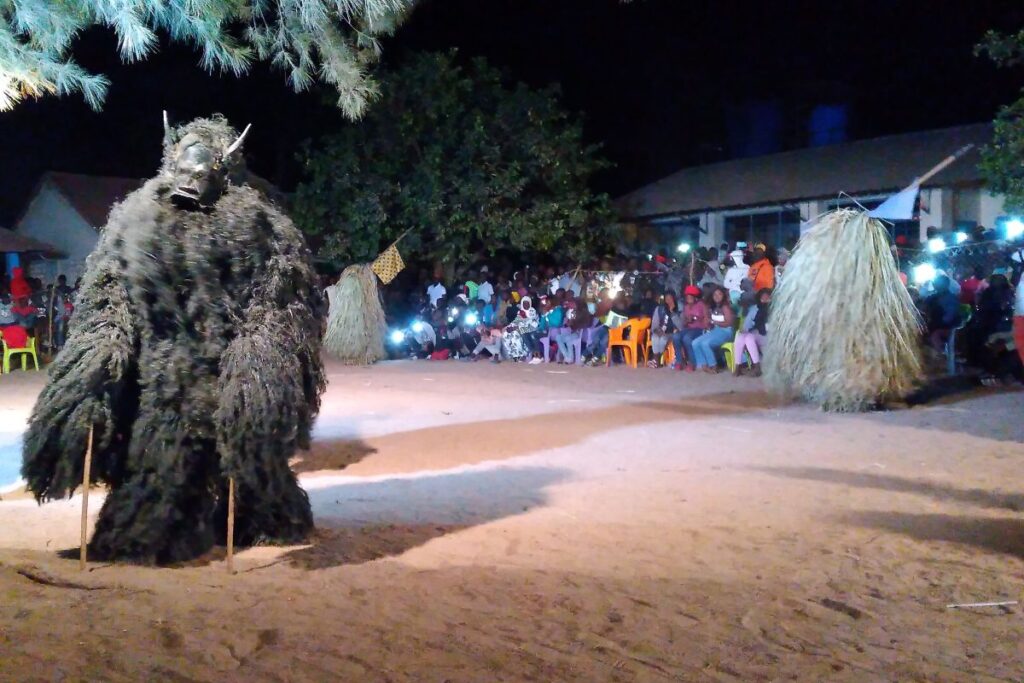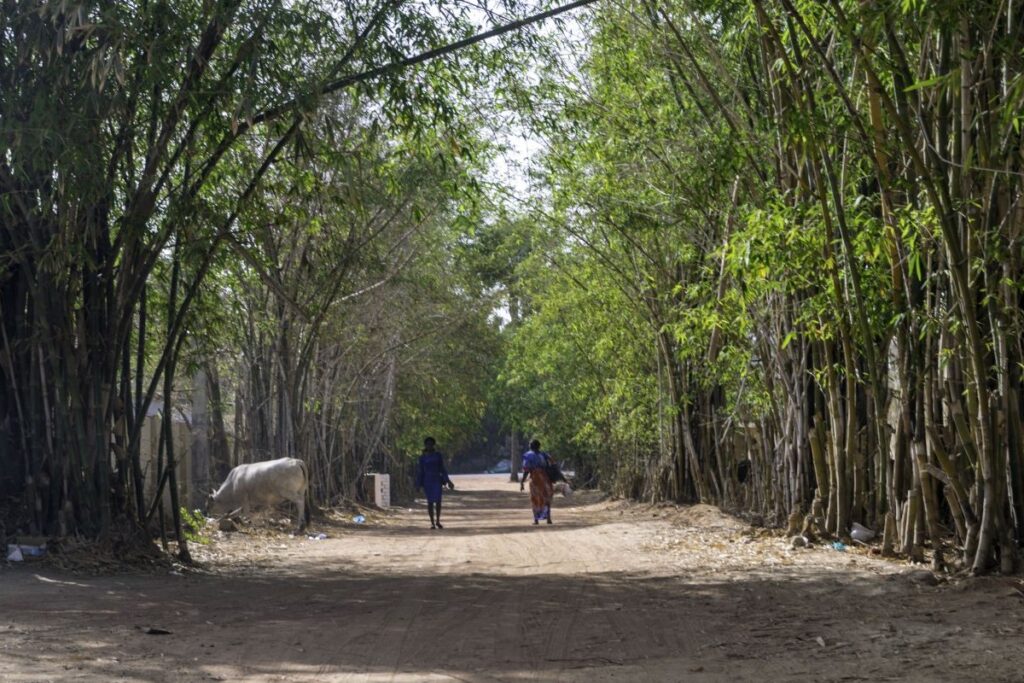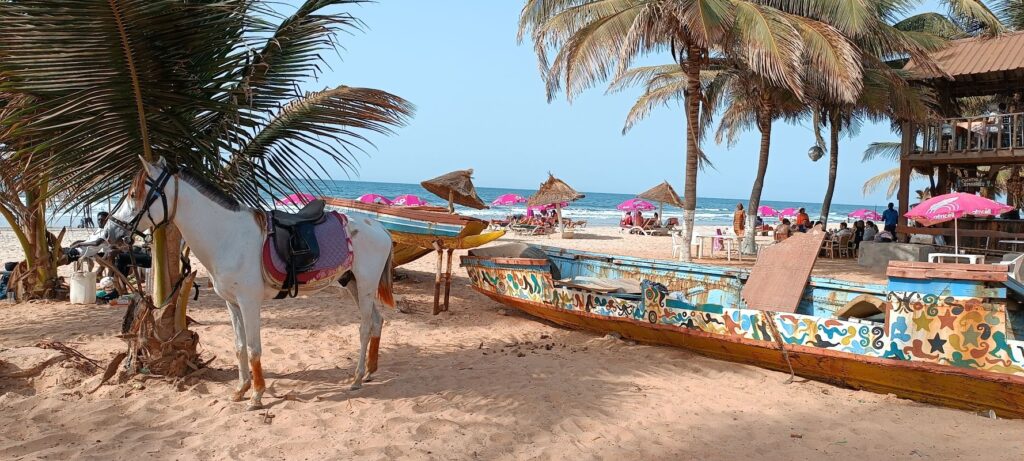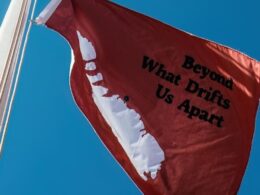The Kumpo is a traditional spiritual figure and masquerade dancer from the Diola people of Senegal and The Gambia, recognizable by its costume of palm leaves and a spinning stick on its head.
Words by Aldith Gauci
In January 2019, I witnessed the kumpo masquerade perform for the first time at the Janjangbureh Kankurang Festival in The Gambia. The festival grounds came alive with the pulsing rhythm of drums, the clatter of wooden clappers and song. Masquerades moved among us, as though the trees and forest creatures themselves had come to dance.

Gradually, the pace of the drumming intensified until all of a sudden, the kumpo leapt into the air and plunged its stick into the earth. It seemed to be moved by wind or spirit, as it began to spin on itself, mesmerising the crowd. They cheered wildly in celebration of this masquerade and its powers, believed to arise from the sacred forest.
Kumpo performances such as this one became central to my ethnographic doctoral research at the University of Exeter, where I explored Jola masquerades as ecoperformances. Looking at the indigenous knowledge and the ecological value system that supports the practice, I wondered: What if art isn’t just meant to entertain or impress? What if it’s a space of refuge, where we can rehearse the values we need to reconnect with each other and with the natural world?

Planetary crisis
Our planet is facing unprecedented pressures: depleting natural resources, rising atmospheric and oceanic temperatures, and ecosystems in crisis. Connected to this is the impact of our lifestyles on our mental health, fuelling feelings of isolation, insecurity and anxiety. Despite widespread efforts to adopt eco-friendly measures, the emergency deepens year after year.
Living in The Gambia (2018 to 2022) I became acutely aware of the excesses built into our daily lives: from wasteful consumption of water and electricity to the hidden energy costs of manufacturing and the emphasis on productivity for consumption as we continue to live beyond our energetic means on a planet with finite resources. It became clear that our way of life is enabling this crisis.
This urgency shaped the conversations at CARPA9, a conference I recently attended at the University of the Arts Helsinki (28-30 August). It brought together scholars and artists to discuss “Ecological Design and Performance Pedagogies – sustainable practices and interdisciplinary acts in a climate changed world”. The organisers collaborated with the Performance + Ecology Research Lab of the Creative Arts Research Institute at Griffith University (Australia) and ensured a truly international exchange. At the conference, I reflected on my fieldwork, highlighting the community-based and sustainable features of the performance and shared observations that suggest adaptations to the environmental crisis. Speaking amongst artist-scholars working at the intersection of ecology and art, I was struck by the breadth of perspectives. Despite the diverse points of our research, a recurring theme was the question of affect: is it enough for ecological art practices to merely speak about the environment? Or can performance engage with environmental systems and communities, to instigate social action and become a catalyst for solutions?

Indigenous knowledges
Many eco artists have used art to raise awareness about extinction and climate change, and many theatre initiatives are adopting green policies focusing on reusing materials and reducing carbon footprints. However, masquerade practice illuminated the importance of an ecological praxis to cultivate the values necessary in our times. For example, in the belief system underpinning the practice, forests, animals and our ancestors are all part of a living community. I examine how indigenous knowledge and community-based values underpinning kumpo can cultivate ecological awareness and suggest new pathways for ecoperformance-making. Unlike conventional theatre, Jola masquerades don’t feature protagonists and applause. With no space for ego, the practice celebrates collective participation, an engagement with the more-than-human—fostering relationships rather than economies.
In my thesis, I propose that ecoperformance can serve to reorient the engagement with our environment, and I develop guiding principles that can be applied to artistic engagement. Among them: localising practices, understanding the true cost of production, and cultivating a non-anthropocentric perspective. I emphasise that while some performances are designed to be consumed, I urge artists who are mindful of our ecological predicament to focus on nourishing relationships as one of the most urgent responses needed in this time.
Fact. Reflection. Fiction. Towards an ecological imagination
In her keynote address at the conference, Finnish dance researcher Raisa Foster highlighted that addressing the climate emergency will require an interdisciplinary, multifaceted approach. Fact. Reflection. Fiction, she highlights. Scientific facts will help us understand what we are dealing with. Reflection allows us to examine how we got here. And, fiction will make it possible to envision new ways of living with “situated ethical sensitivities” (Foster). This is what the arts can offer because this is what we have been practising: building alliances, adapting to uncertainties, advocating for social engagement and speculating new beginnings.
Looking ahead, I hope to bring these insights to artistic projects, interventions and pedagogical settings. The goal is not only to make art more sustainable, but to drive art practices that can sustain us.
Gauci is a recipient of the Malta Tertiary Education Scholarship Scheme, and her conference participation was supported by Arts Council Malta.










